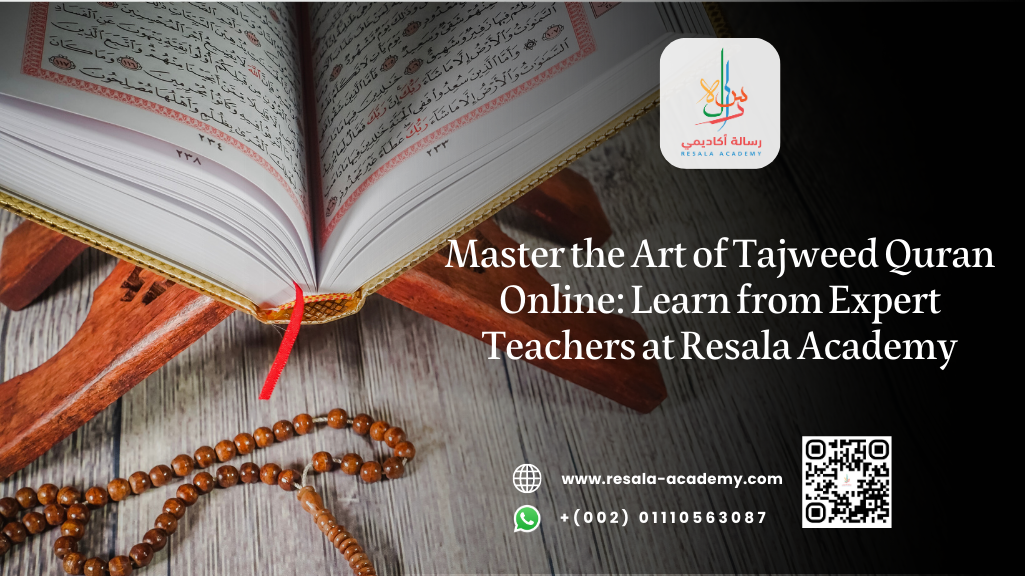Table of Contents
Phonetic Challenges in Al Quran Tajweed for Non-Native Speakers: A Comparative Linguistic Analysis
The recitation of the Holy Quran is a sacred act that transcends mere reading—it is a spiritual, linguistic, and phonetic journey. For non-native speakers, mastering the art of Al Quran Tajweed—the rules governing pronunciation during Quranic recitation—presents unique challenges.
These challenges are not merely about learning a new language but involve navigating intricate phonetic nuances deeply rooted in classical Arabic.
This article delves into the phonetic challenges faced by non-native speakers when learning Tajweed, offering a comparative linguistic analysis, practical insights, and effective solutions. It also highlights the role of online institutions like Resala Academy, which specializes in teaching Arabic and the Quran to non-native speakers.
What Is Tajweed in the Quran?
Tajweed (تَجْوِيد) means “to make better” or “to improve.” In the context of the Quran, it refers to the set of rules that govern proper pronunciation during recitation. These rules ensure that the Quran is recited as it was revealed to the Prophet Muhammad ﷺ, preserving its linguistic and spiritual integrity.
Tajweed encompasses:
- Makharij al-Huruf (مخارج الحروف): Points of articulation of the letters.
- Sifaat al-Huruf (صفات الحروف): Characteristics of the letters.
- Rules of Noon Saakinah and Tanween
- Rules of Meem Saakinah
- Lengthening (Madd)
- Stopping (Waqf) and Starting (Ibtida)
Understanding these rules is essential for anyone striving to recite the Quran correctly, especially for non-native speakers who may not be familiar with Arabic phonology.
Phonetic Challenges in Al Quran Tajweed for Non-Native Speakers
1. Unfamiliar Phonemes
Many Arabic phonemes do not exist in other languages, making them difficult for non-native speakers to pronounce. For example:
- The letter ع (‘Ayn) is a voiced pharyngeal fricative, which has no equivalent in English or many other languages.
- The letter ق (Qaf) is pronounced from the uvula, a sound that is often softened or mispronounced by learners.
- The ص (Saad), a heavy or emphatic “s”, is often confused with the regular س (Seen).
These phonemes require precise articulation, which can be challenging for learners whose native languages lack similar sounds.
2. Makharij (Articulation Points)
Arabic has 17 articulation points for its 29 letters. Non-native speakers often struggle to identify and produce these sounds accurately. For instance:
- Ha (ح) is pronounced from the middle of the throat, unlike the English “h”.
- Kha (خ) is a voiceless fricative from the upper throat, often mispronounced as “k” or “h”.
3. Sifaat (Characteristics of Letters)
Each Arabic letter has specific characteristics such as Qalqalah (echoing sound), Tafkheem (heaviness), and Tarqeeq (lightness). Misapplying these can change the meaning of words in the Quran.
Example:
قَدْ أَفْلَحَ الْمُؤْمِنُونَ
“Successful indeed are the believers.”
If قَدْ is pronounced lightly instead of heavily, it alters the phonetic integrity of the verse.
4. Lengthening (Madd)
Arabic has specific rules for elongating vowels. Non-native speakers often either overextend or under-pronounce these vowels, affecting the rhythm and meaning of the recitation.
Example:
وَلَا الضَّالِّينَ
“Nor those who went astray.”
The word الضَّالِّينَ must be elongated for six counts. Mispronouncing it can change the flow and emphasis of the verse.
5. Influence of Native Language
Learners often unconsciously apply the phonetic rules of their native language when reading Arabic. This phenomenon, known as language interference, can lead to persistent pronunciation errors.
For example:
- French speakers may nasalize vowels.
- Urdu speakers may overemphasize certain emphatic letters.
- English speakers may flatten the Arabic “r” (ر) into a soft English “r”.
Comparative Linguistic Analysis
Arabic vs. English
Feature | Arabic | English |
Phoneme Inventory | 28 consonants, 6 vowels | 24 consonants, 20 vowels |
Emphatic Consonants | Present (e.g., ص, ط, ظ) | Absent |
Articulation Points | 17 Makharij | Fewer, less distinct articulation |
Script | Right-to-left, cursive | Left-to-right, non-cursive |
Arabic vs. French
Feature | Arabic | French |
Nasal Sounds | Rare | Common |
Pharyngeal Sounds | Common (e.g., ع, ح) | Absent |
Uvular Consonants | Present (ق) | Rare |
Understanding these differences helps educators tailor their teaching methods to the phonetic background of the learner.
Effective Strategies for Overcoming Tajweed Challenges
Phonetic Drills
- Repetition of difficult sounds like ع, غ, and ق
- Use of mirror exercises to observe tongue and lip movement
- Listening to expert reciters like Abdul Basit
Visual Aids
- Diagrams of articulation points
- Video tutorials illustrating proper mouth and throat positions
Personalized Feedback
- One-on-one sessions with certified Tajweed teachers
- Audio recording and playback for self-assessment
Structured Online Courses
Institutions like Resala Academy offer structured Tajweed courses tailored for non-native speakers, combining phonetic training with spiritual enrichment.
Quranic and Hadith Evidences
1. Quran – Surah Al-Muzzammil (73:4)
وَرَتِّلِ الْقُرْآنَ تَرْتِيلًا
“And recite the Quran with measured recitation.”
This verse emphasizes the importance of Tarteel, which includes proper pronunciation and rhythm, core elements of Tajweed.
2. Hadith – Sahih Bukhari
The Prophet Muhammad ﷺ said:
“The best among you are those who learn the Quran and teach it.”
(Sahih Bukhari, Book 61, Hadith 546)
This Hadith highlights the virtue of learning and teaching the Quran, which includes mastering its recitation.
Struggling with Tajweed as a non-native speaker? Unlock the beauty of Quranic recitation with this beginner-friendly, step-by-step guide to mastering Tajweed rules—designed just for you. Start your journey today!
Advanced Phonological Nuances in Al Quran Tajweed
- Precision in Heavy and Light Letters (Tafkheem vs. Tarqeeq):
Mastering the balance between heavy (e.g., ص, ض, ط) and light letters (e.g., س, ذ, ت) is crucial in Al Quran Tajweed. Mispronunciation can alter the meaning of divine verses, making this distinction vital for accurate recitation.
- Mastering the Ghunna (Nasalization):
The nasal sound, known as Ghunna, appears in rules like Idgham and Ikhfa. Non-native speakers often struggle with its duration and intensity. Practicing with audio tools and Tajweed-focused apps can help internalize this subtle yet essential element. - Sukoon and Shaddah Recognition:
Understanding how to pause (Sukoon) and emphasize (Shaddah) consonants is a cornerstone of Tajweed. These diacritical marks guide the rhythm and flow of recitation, and misapplying them can disrupt the intended cadence of the Quran. - Echoing Sound (Qalqalah) Mastery:
Letters such as ق, ط, ب, ج, and د require a bouncing sound when in a state of sukoon. This phonetic feature is unique to Al Quran Tajweed, and mastering it demands focused articulation practice. - Application of Madd (Elongation) Rules:
The rules of Madd Tabee’i, Madd Munfasil, and Madd Muttasil involve extending vowel sounds for specific durations. These rules enhance the musicality and rhythm of the Quran and must be applied precisely to preserve meaning and beauty. - Correct Use of Waqf (Stopping Rules):
Knowing where and how to pause during recitation is not just a matter of breath control but also of semantic understanding. The rules of Waqf ensure that the message of the Quran is conveyed without distortion. - Phonetic Consistency Across Dialects:
Arabic dialects vary, but Al Quran Tajweed adheres strictly to classical Arabic. Learners must unlearn regional pronunciations and adopt the standardized phonology of Quranic Arabic to achieve correct recitation. - Integration of Tajweed with Memorization (Hifz):
Tajweed is not isolated from memorization. Applying Tajweed rules during Hifz reinforces correct pronunciation and helps embed the verses more deeply in memory. - Utilizing Spectrograms and Phonetic Software:
Advanced learners can benefit from using linguistic software to visualize sound waves and articulation points. This modern approach bridges the gap between theoretical rules and practical application. - Tajweed in Emotional and Spiritual Expression:
Beyond technical correctness, Tajweed enhances the emotional delivery of Quranic verses. Proper pronunciation allows the reciter to convey the depth and gravity of divine messages, fostering a more profound spiritual experience.
Digital Solutions and Structured Learning for Al Quran Tajweed Mastery
- Interactive Tajweed Platforms:
Online platforms like Resala Academy offer interactive Tajweed lessons with real-time feedback. These courses are tailored for non-native speakers and include visual aids, quizzes, and audio exercises to reinforce learning. - Gamified Learning Modules:
Incorporating gamification into Tajweed instruction, such as point systems, badges, and progress tracking, keeps learners motivated and engaged. This is especially effective for children and beginners. - Structured Curriculum with Progressive Levels:
A step-by-step curriculum that begins with basic phonetics and advances to complex Tajweed rules ensures that learners build a solid foundation before moving to higher levels. - Live One-on-One Coaching Sessions:
Personalized coaching is one of the most effective ways to master Al Quran Tajweed. Institutions like Resala Academy provide certified instructors who tailor lessons to the learner’s pace and linguistic background. - Community Learning and Peer Review:
Engaging in group classes and peer recitation circles fosters a sense of community and provides opportunities for mutual correction and encouragement. - Tajweed Certification Programs:
Earning a certificate in Tajweed not only validates your proficiency but also motivates consistent improvement. Many online academies offer internationally recognized certifications upon course completion. - Incorporating Quranic Context in Tajweed Learning:
Understanding the meaning and context of verses enhances pronunciation accuracy. When learners grasp the emotional and moral weight of a verse, they are more likely to recite it with the appropriate tone and emphasis. - Daily Practice Schedules and Recitation Logs:
Maintaining a daily Tajweed practice log helps track progress and identify recurring mistakes. Consistency is key to mastering the intricate rules of Quranic recitation. - Access to Renowned Qaris and Recitation Models:
Learners should regularly listen to expert Qaris like Sheikh Sudais, Sheikh Minshawi, or Sheikh Al-Husary to internalize the correct application of Tajweed rules in real-time recitation.
These advanced strategies and digital tools are transforming how non-native speakers approach Al Quran Tajweed, making it more accessible, engaging, and effective than ever before.
Whether you’re a beginner or an advanced learner, integrating these specialized techniques will elevate your recitation and deepen your connection with the Quran.
Resala Academy: Your Gateway to Mastering Al Quran Tajweed
Resala Academy is a leading online institution dedicated to helping non-native speakers master Arabic and the Al Quran Tajweed course.
With certified teachers, interactive lessons, and personalized feedback, Resala Academy ensures that students not only learn the rules but also internalize them for life.
Key Features:
- Native Arabic-speaking instructors
- Flexible scheduling to suit global time zones
- One-on-one and group classes
- Special Tajweed courses for children and adults
- Free trial classes available
Start your journey today with Resala Academy and recite the Quran the way it was meant to be recited.
FAQs
1. What is the best way to learn Al Quran Tajweed as a non-native speaker?
The best approach combines structured online lessons, phonetic drills, and consistent practice. Enrolling in a specialized academy like Resala Academy provides expert guidance and feedback.
2. How long does it take to master Tajweed?
It varies by individual, but with regular practice and proper instruction, most learners can achieve proficiency in 6–12 months.
3. Can children learn Tajweed online?
Absolutely! Resala Academy offers child-friendly Tajweed programs that use games, visuals, and interactive tools to make learning fun and effective.
4. Is Tajweed mandatory for Quran recitation?
While not obligatory for general reading, Tajweed is essential for proper recitation, especially during prayer and formal recitation. It preserves the meaning and beauty of the Quran.
5. What if I can’t pronounce certain Arabic letters?
Don’t worry! With expert guidance, phonetic exercises, and patience, most learners overcome these hurdles. Resala Academy specializes in helping non-native speakers master difficult sounds.
Conclusion
Mastering Al Quran Tajweed is a noble and rewarding endeavor, especially for non-native speakers. While the phonetic challenges are real, they are not insurmountable.
With the right guidance, structured learning, and spiritual motivation, anyone can learn to recite the Quran beautifully and correctly.
By understanding the linguistic differences, employing effective learning strategies, and enrolling in reputable institutions like Resala Academy, learners can overcome these challenges and connect more deeply with the divine message of the Quran.
Ready to start your Tajweed journey? Visit Resala Academy and enroll in a free trial class today!




